During the 1934-35 season, Schmidt scored 20 goals and 26 points in 17 games for his hometown junior team the Kitchener Greenshirts. Following the season, Schmidt and his childhood friends and Greenshirts linemates Bobby Bauer and Woody Dumart were all signed by the Boston Bruins.
Schmidt remained with Kitchener for the 1935-36 season, while Dumart and Bauer spent the year with the Boston Cubs in the Can-Am league. While Bauer outscored Dumart with 15 goals and 28 points to Dumart's 11 and 21, it was Dumart who made his NHL debut first, playing in one game for the Bruins that season.
For the 1936-37 season, the trio was reunited with the Providence Reds of the International-American Hockey League. It was in Providence that they became known as "The Kraut Line" due to their shared German heritage thanks to the Reds head coach Albert Leduc.
After 23 games, Schmidt was called up by the Bruins for 26 games, which saw him score his first 2 NHL goals on his way to 10 total points. Dumart joined him after 34 games, seeing action in 17 games. Bauer also made his NHL debut that season when he was called up for the final regular season game for the Bruins. Giving a clue as to what was to come, the three childhood friends teamed up to score their first goal as a line just minutes into their first NHL game together.
By 1937-38, all three were now full time members of the Bruins, with right wing Bauer leading the way with 20 goals and 34 points. Left winger Dumart and center Schmidt each had an identical 13 goals and 27 points. At 6' 1" Dumart was the checker and defensive component of the line, while Schmidt was the leading scorer of the group.
Schmidt would have 15 goals and 32 points in 1938-39, good for third on the team. The Bruins finished first in the NHL that season with a 36-10-2 record and then went on to win one of the most dramatic playoff series in NHL history.
After winning the first three games against the New York Rangers, the first of which was a 2-1 triple overtime thriller on the road in New York. Game 2 in Boston also required overtime before the Bruins prevailed. The Rangers then came back to win Game 4 at home 2-1 and Game 5 in Boston 2-1 in yet other overtime game. The Rangers then became the first team in league history to force a Game 7 after losing the first three of the series with a 3-1 win at home. The Bruins finally prevailed in triple overtime in Game 7 by yet another 2-1 game, the fourth 2-1 game of the hard fought series. Of note, Mel Hill had all three overtime winners for the Bruins.
In the Stanley Cup Finals, the Bruins, behind the goaltending of Frank Brimsek, held the Toronto Maple Leafs to 6 goals in the five game series, won by the Bruins 4 games to 1 to make the childhood friends Schmidt, Dumart and Bauer Stanley Cup champions.
Schmidt would lead not only the Bruins in scoring for the first time in 1939-40, but the entire NHL as well with 22 goals and 52 points in a then 48 game schedule to earn Schmidt the Art Ross Trophy. His 52 points were followed by linemate Dumart and Bauer, each tied with 43 points, as the Kraut Line would finish 1-2-3 in league scoring. If that weren't enough, teammate Bill Cowley was fourth with 40 points as Bruins took the top four spots.
The Bruins again finished first in the league in 1940-41 and again had to survive a seven game Semifinal series against the Maple Leafs, a back and forth series that required the Bruins to win the final two games to advance before a four game sweep of the Detroit Red Wings to claim their second Stanley Cup in three seasons.
After 36 games of the 1941-42 season, Schmidt, Dumart and Bauer and all enlisted in the Royal Canadian Air Force due to World War II. After their final game before leaving, they were honored by being carried off the Boston Garden ice by the Montreal Canadiens players.
Schmidt always maintained that night was his biggest thrill in hockey. "That was the last game Bobby Bauer, Pork Dumart and I played before going into the service," Schmidt recalled. "It was against the Canadiens, and we beat them badly. I don't think I'll ever forget what happened after the game. The players on both teams lifted the three of us on their shoulders and carried us off the ice and the crowd gave us an ovation. A man couldn't ever forget a thing like that."
While in the military, the line joined the Ottawa RCAF Flyers team in time for the team's playoffs. After winning the Ottawa City Hockey League, they advanced to the national Finals, where they defeated the Port Arthur Bearcats 3 games to 2 to win the Allan Cup as senior champions of Canada. During the Allan Cup playoffs, Dumart had 6 goals and 23 points in 13 games.
Schmidt then spent the next three years away from the game after being shipped overseas for the duration of his time in the military.
After four seasons away from the NHL, Schmidt returned to the Bruins for the 1945-46 season along with Dumart and Bauer. Schmidt picked up right where he left off by scoring 13 goals and 31 points, coming within 4 points of his last season with Boston prior to leaving for the service. The Bruins would make it to the Stanley Cup Finals during the Kraut Line's return season before falling in five games to the Canadiens.
In 1946-47, Schmidt would then set career highs with 27 goals and 62 points to lead the Bruins in scoring for the second time. Following the season, Bauer, despite having just completed a career year of his own with 30 goals and 54 points in 58 games, would announce his retirement from the NHL to manage his father-in-law's skate business, bringing to an end the era of the Kraut Line after seven seasons together with Dumart and Schmidt.
Injuries due to his all out playing style would begin to catch up to Schmidt, and he was limited to just 33 games of the 1947-48 season. It was more of the same in 1948-49 when he was on the ice for just 44 of Boston's 60 games.
Schmidt would put his injury woes behind him for the next five seasons, playing in a minimum of 62 games, highlighted by a 22 goal, 61 point season in 1950-51, the second highest point total of his career and third time he would lead the Bruins in scoring.
Schmidt named the Bruins team captain for the 1951-52 season and again led Boston in scoring after another 20 goal season with 21 as well as 29 assists for 50 points, his fourth and final season of 50 points or more. His efforts would be recognized when he was named the winner of the Hart Trophy as the league's MVP.
While his point total would drop to 34 in 1952-53, the Bruins would return to the Stanley Cup Finals. Despite Boston finishing third in the regular season, they upset the first place Red Wings to advance to face Montreal, before falling in five games.
In 1953-54, Schmidt would score 14 goals and 32 points, his 13th season of ten or more goals and 12th of 30 points or more out of 16 seasons. His final season as a player came in 1954-55, when he retired after 23 games to become the Bruins head coach.
He would coach the Bruins for 11 seasons from 1954-55 to 1965-66, save for the 1961-62 season. He would lead the team to the finals in 1957 and 1958. He was promoted to being the team's General Manager in 1967, just as the league was expanding from 6 to 12 teams.
As the General Manager, Schmidt oversaw two Stanley Cup championships in 1970 and 1972 and was the architect of the famous trade that brought Boston Phil Esposito, Ken Hodge and Fred Stanfield.
His final NHL totals were 776 games, 229 goals and 346 assists for 575 points, numbers which would have been higher had he not had to miss three full seasons while away in the military. At the time of his retirement, Schmidt was fourth in NHL history in points and third in assists.
Schmidt would play in the first two NHL All-Star Games in 1947 and 1948 and again in 1951 and 1952. He would win the Art Ross Trophy as the league scoring champions and Hart Trophy as league MVP and a pair of Stanley Cups.
He was inducted into the Hockey Hall of Fame in 1961 and the Bruins would retire his #15 in 1980.
Today's featured jersey is a 1950-51 Boston Bruins Milt Schmidt jersey the style worn by Schmidt when he won the Hart Trophy as the Most Valuable Player in 1951.
A very similar jersey was introduced by the Bruins for their for their 25th Anniversary in 1948-49, only with black shoulders and a single white stripe trimmed in gold around the arms and waist.
For the 1949-50 season, the jersey was reworked so that it now had gold shoulders and a single yellow stripe trimmed in white on the arms with two white trimmed gold stripes around the waist. One of the most attractive, yet least known NHL jerseys, this style would be worn by the Bruins for six seasons through the end of Schmidt's playing career.
After this striping pattern first arrived in 1939-40 with black numbers for one season, the team swapped the colors of the numbers and logos for the 1940-41 season. This style remained in use through the 1947-48 season until the Bruins introduced their now famous Spoked B logo for their 25th Anniversary in 1948-49.
Extra bonus jersey: Today's extra bonus jersey is a 1948-49 Boston Bruins Milt Schmidt jersey. This style was worn by Boston for their 25th Anniversary season and was the first appearance of their now iconic Spoked B logo. Flaking the letter B are the numbers 24 and 49, representing the year of their formation and their anniversary season.
After the crest of the Bruins 25th anniversary jersey was changed to a block letter B for 1949-50, the sleeve striping was changed for the 1951-52 season and was worn through the 1957-58 season. The following season the top four sleeve stripes narrowed considerably and that evolution of this jersey lasted through Bobby Orr's rookie season of 1966-67.

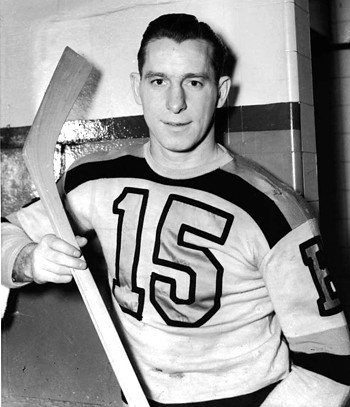
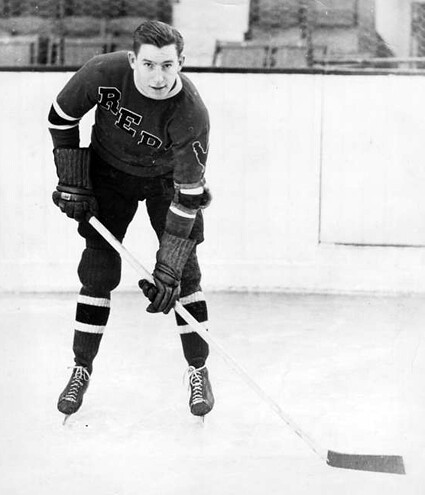
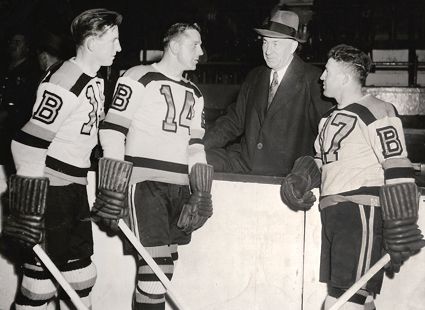
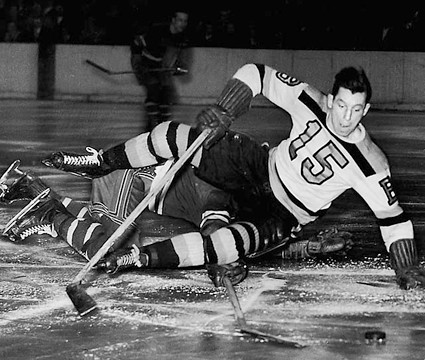
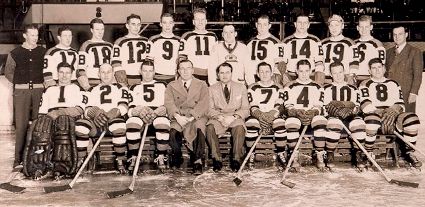
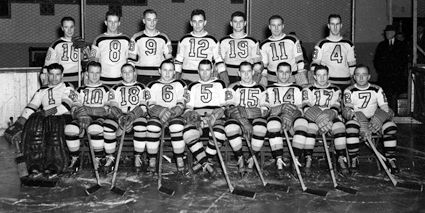
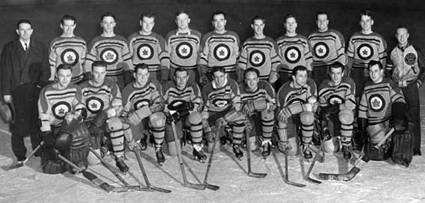
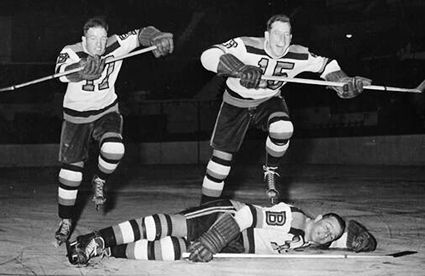
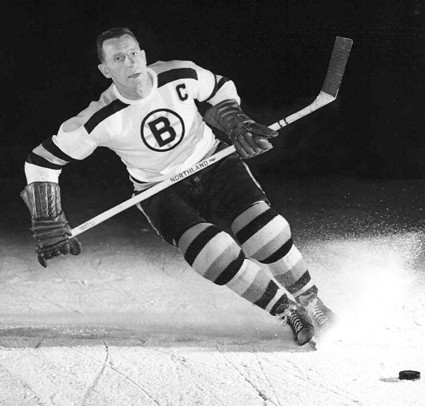
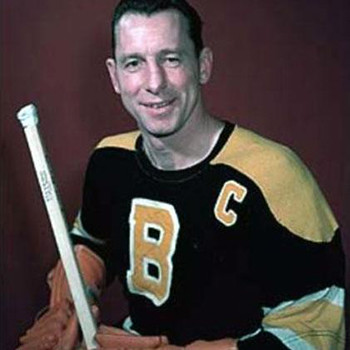
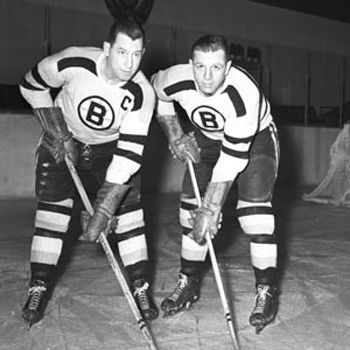
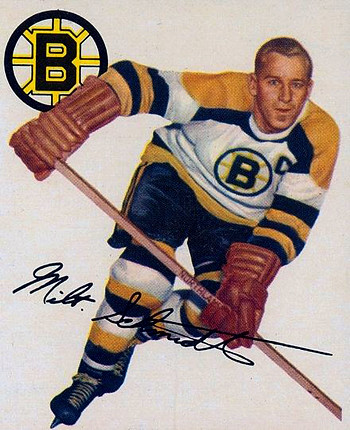
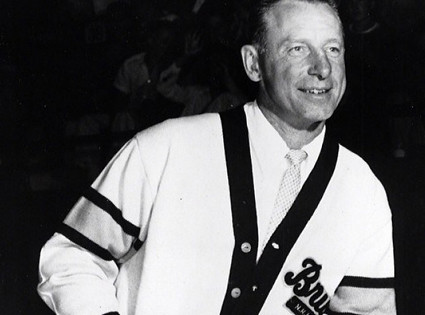
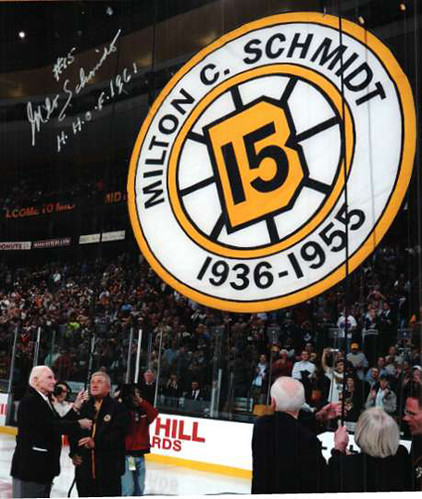
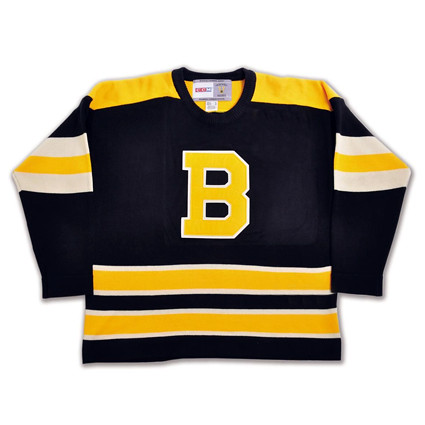
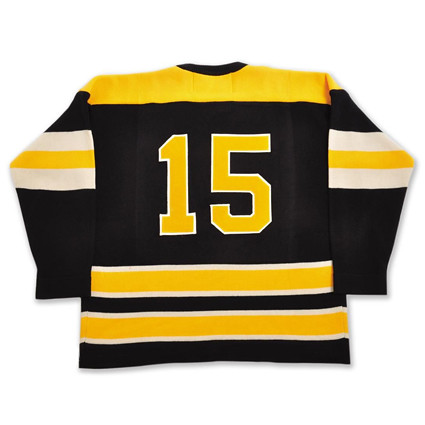
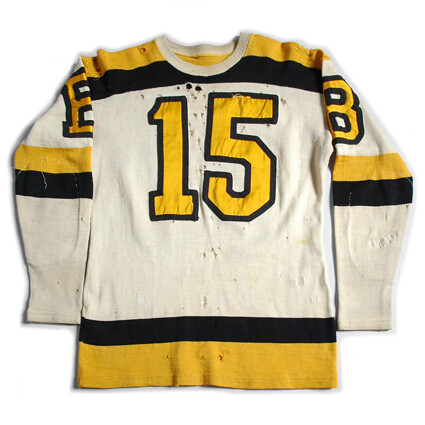
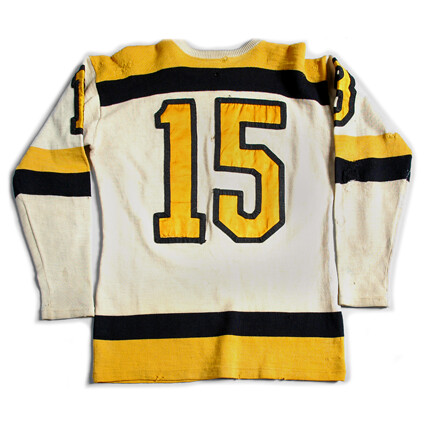
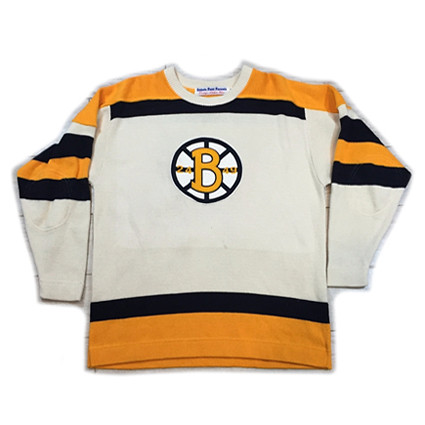
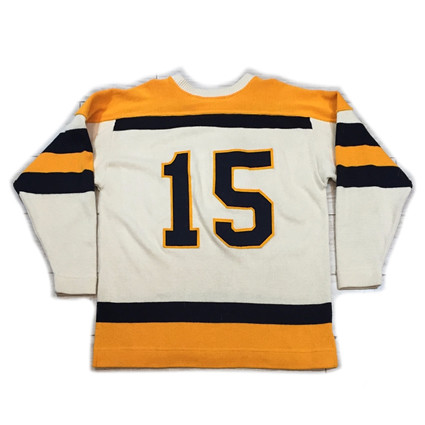

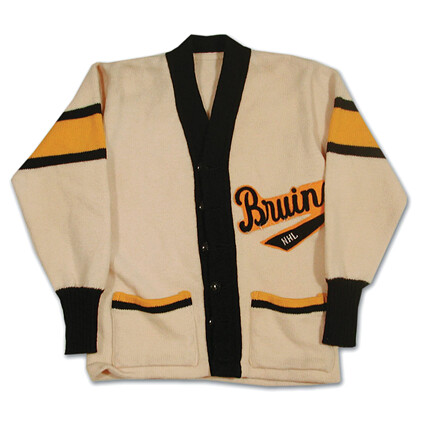
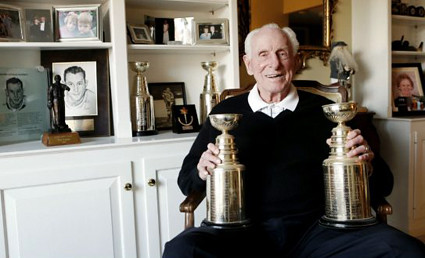










No comments:
Post a Comment
We welcome and encourage genuine comments and corrections from our readers. Please no spam. It will not be approved and never seen.